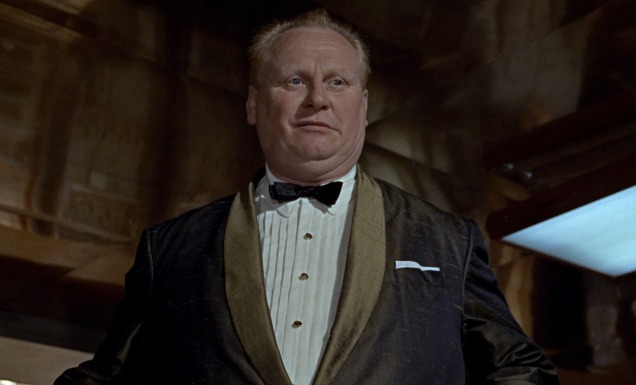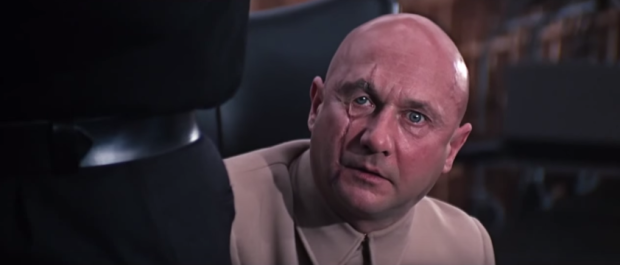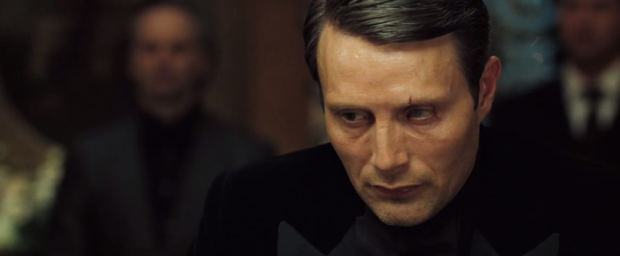For a half century, the villain, a hallmark of the James Bond series, has been the yardstick in which an entry’s quality is measured. With less than a week’s time before the U.S. release of Spectre, the 2 Shot‘s Nick Fleming looks back at the seven quintessential Bond antagonists.
Going to the theater to watch a 007 adventure epitomizes escapism. As the lights dim, audiences enter an exotic world filled with intrigue, vibrancy, and danger. Along the way, viewers are promised to meet a cast of larger-than-life characters: men and women who are good, bad, and pure evil. Like James Bond himself, many of the villains, henchmen, and femme fatales to grace the silver screen have become so iconic, they have seeped into popular culture and our collective memory as the stuff of nightmares, mystery, and fun.
The 2 Shot Presents
The Essential 007 Villains
Donald “Red” Grant (Robert Shaw) in From Russia with Love, 1963
One of James Bond’s earliest and most realistic antagonists is the “homicidal paranoiac,” Red Grant. In peak physical condition, Grant is assigned by SPECTRE to assassinate 007 en route to England.
Audiences and critics commonly refer to From Russia with Love as one of, if not the, best entry in the series. Robert Shaw’s performance of Grant is a major highlight. Often seen on the peripheral, he stalks Bond from afar waiting to execute SPECTRE’s plan.
In a peculiar sense, Grant is a dark reflection of the British spy: a handsome man respected by his superiors with a lethal set of skills. When the two men engage in hand-to-hand combat aboard the Orient Express, Bond is evenly matched.
"The first one won't kill you; not the second, not even the third... not till you crawl over here and you KISS MY FOOT!" - Donald "Red" Grant
Auric Goldfinger (Gert Fröbe) in Goldfinger, 1964
With an almost perverted obsession with gold, Auric Goldfinger breaks from series tradition in the sense he is apolitical. Working for nobody but himself, he hatches a plan to radioactively contaminate Fort Knox’s gold supply, ensuring that the value of his own gold will multiply.
It all sounds convoluted, but the film, and most certainly the character, marked an artistic turning point for the series. From the story, to 007, and the villain himself, everything became more fantastical.
However, Goldfinger‘s tongue-in-cheek tone succeeds when it failed so miserably in other entries because of the performances, particularly Gert Fröbe’s chilling, yet oddly likable, turn as the film’s titular character.
"Man has climbed Mount Everest, gone to the bottom of the ocean. He's fired rockets at the Moon, split the atom, achieved miracles in every field of human endeavor... except crime!" - Auric Goldfinger
Oddjob (Harold Sakata) in Goldfinger, 1964
The brawn to Goldfinger’s brains, the peculiarly named servant, Oddjob, appears unsettling without the formulaic deformity bestowed to so many of the series’ villains. Without uttering a single word, Oddjob has the menace of the off-screen leader of SPECTRE and the physicality of Red Grant.
Alongside the film’s title character, Oddjob has been immortalized as one of cinema’s most iconic villains.
Fiona Volpe (Luciana Paluzzi) in Thunderball, 1965
As the sixties carried on, the series was more than a box office sensation; it was a cultural phenomenon. To demonstrate that a Bond picture had what imitators did not, United Artists granted Thunderball a $5.6 million budget. With bigger action and more gadgets, there is an unfortunate lack of characterization plaguing the film. By this point, Sean Connery publicly complained that playing 007 was fast becoming a bore. Thunderball was to be his last great performance as Bond.
There is, however, a beacon of light present in the form of Fiona Volpe. Intelligent, sensual, and absolutely sinister, the black widow-like assassin demands audience attention as Luciana Paluzzi’s performance pushes the villainess troupe to exciting extremes.
"But of course, I forgot your ego, Mr. Bond. James Bond, the one where he has to make love to a woman, and she starts to hear heavenly choirs singing. She repents, and turns to the side of right and virtue... but not this one!" -Fiona Volpe
Ernst Stavro Blofeld (Donald Pleasence) in You Only Live Twice, 1967
After the phenomenal success of 1965’s gadget-laden Thunderball, once again pitting James Bond against the forces of SPECTRE, producers Harry Saltzman and Albert R. Broccoli saw no reason to stray from a winning formula.
After two films, 007 finally comes face to face with SPECTRE mastermind, Ernst Stavro Blofeld. Breaking from the continuity of the character established in Russia and Thunderball, Blofeld is played by Donald Pleasence with eerie, low-key menace.
His appearance, famously lampooned by Mike Myers’ Dr. Evil in the Austin Powers series, is one of You Only Live Twice‘s highlights. Though the character would later be played by both Telly Savalas and Charles Gray, Pleasence’s unsettling performance and grotesque appearance are what resonate.
"You only live twice, Mr. Bond." -Ernst Stavro Blofeld
Dr. Kananga/Mr. Big (Yaphet Kotto) in Live and Let Die, 1973

In 1973, Bond dived into the blaxploitation sub-genre. With its unforgiving Louisiana boat chases and uncomfortable uses of the word “boy,” Live and Let Die is remarkable for being truly of its time. After the success of movies like Shaft (1971) and Super Fly (1972), producers wanted to capitalize on the trend.
For this, they loosely adapted Ian Fleming’s second 007 book, which features several black characters, including the villain Mr. Big (Dr. Kananga was created for the film).
Kananga stands out as one of the few villains of color in the series. But that’s not all at play here. Yaphet Kotto is commanding as Kananga. He’s so suave — we could even call him one of the sexier villains — yet behind the smile is utter menace. Others fear him. Kotto chews the scenery, but he does it o so well.
"Names is for tombstones, baby." -Dr. Kananga/Mr. Big
Jaws (Richard Kiel) in The Spy Who Loved Me, 1977
Barring little to no resemblance to Ian Fleming’s story, The Spy Who Loved Me added another addition to Bond’s Rogue Gallery. Loosely based on one of the novel’s henchman, the aptly named Horror, the steel-toothed Jaws is a far more innovative creation.
Another in a line of mute 007 henchmen, Jaws is hired by the film’s primary villain, Carl Stromberg, to erase James Bond from the equation. Throughout the film, the towering giant is both terrifying and comedic.
Originally intended to die during the film’s climax, producer Albert R. Broccoli vetoed the idea, sensing the character’s appeal with audiences would be too great to cut short. Broccoli’s senses were on point. Two years later, Jaws returned to fight against (and beside) 007 in 1979’s Moonraker.
Le Chiffre (Mads Mikkelsen) in Casino Royale, 2006
As Red Grant matched Bond as a spy, Le Chiffre is his match at the poker table. While he has the looks and charm, there’s something eely about him. Mikkelsen’s stare can be terrifying.
One of the great things about the character is that he is not in control. After a bombing is averted by Bond, Le Chiffre must scramble to pay back over a hundred million dollars from his terrorist donors.
The notorious torture scene doesn’t come from a sadistic side. Rather, it’s an act of desperation.
"You know, I never understood all these elaborate tortures. It's the simplest thing... to cause more pain than a man can possibly endure. And of course, it's not only the immediate agony, but the knowledge that if you do not yield soon enough there will be little left to identify you as a man." -Le Chiffre
Vesper Lynd (Eva Green) in Casino Royale, 2006
Who are the greatest villains? The crazed industrialists? The terrorists? The eccentric scientists and henchmen? Perhaps the treacherous are the greatest of all. Dante did put them in the ninth circle of hell.
In Vesper Lynd, we have a woman who matches Bond on many levels. Both are orphans, broken in ways, highly intelligent, and perceptive. She trades verbal jabs on par with Bond, getting the upper hand more than once. In Casino Royale, she does indeed seem to be the one worth giving everything up for.
“I have no armor left,” says Bond. “You’ve stripped it from me.” He lets her in, and he lets himself care and love another person. She betrays him. The ultimate irony: when he drops his guard, he’s harmed more viciously than any knife, bullet, or knot of rope could.
The “bitch is dead,” but Bond is broken. This is the event that truly makes him Bond. James Bond.
"I'm afraid I'm a complicated woman." -Vesper Lynd









James Bond: Do you expect me to talk?
Auric Goldfinger: No, Mr. Bond, I expect you to die!
LikeLike